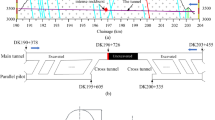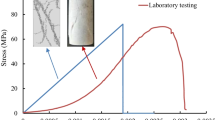Abstract
The research on the rock burst prediction was made on the basis of seismology, rock mechanics and the data from Dongguashan Copper Mine (DCM), the deepest metal mine in China. The seismic responses to mining in DCM were investigated through the analyses of the spatio-temporal distribution of hypocenters, apparent stress and displacement of seismic events, and the process of the generation of hazardous seismicity in DCM was studied in the framework of the theory of asperity in the seismic source mechanism. A method of locating areas with hazardous seismicity and a conceptual model of hazardous seismic nucleation in DCM were proposed. A criterion of rockburst prediction was analyzed theoretically in the framework of unstable failure theories, and consequently, the rate of change in the ratio of the seismic stiffness of rock in a seismic nucleation area to that in surrounding area, dS/dt, is defined as an index of the rockburst prediction. The possibility of a rockburst will increase if dS/dt>0, and the possibility of rock burst will decrease if dS/dt<0. The correctness of these methods is demonstrated by analyses of rock failure cases in DCM.
Similar content being viewed by others
References
MENDECKI A J. Seismic monitoring in mines [M]. London: Chapman & Hall, 1997: 220–245.
LASOCKI S, ORLECKA-SIKORA B. Seismic hazard assessment under complex source size distribution of mining-induced seismicity [J]. Tectonophysics, 2008, 456: 28–37.
ABDUL-WAHED M K, AL-HEIB M, SENFAUTE G. Mininginduced seismicity: Seismic measurement using multiplet [J]. International Journal of Coal Geology, 2006, 66: 137–147.
AKI K. Asperities, barriers, characteristic earthquakes and strong motion prediction [J]. Journal of Geophysical Research, 1984, 89: 5867–5872.
TANG Chun-an, FU Yu-fang, ZHAO Wen. Numerical simulation of growth of seismic source simulation [J]. Journal of Earthquake, 1997, 19(4): 377–346. (in Chinese)
LEI X, MASUDA K, NISHIZAWA O. Detailed analysis of acoustic emission activity during catastrophic fracture of faults in rock [J]. Journal of Structural Geology, 2004, 26: 247–258.
DRIAD-LEBEAUA L, LAHAIEA F, AL HEIBA M. Seismic and geotechnical investigations following a rockburst in a complex French mining district [J]. International Journal of Coal Geology, 2005, 64: 66–78.
SILENY J, MILEV A. Source mechanism of mining induced seismic events: Resolution of double couple and non double couple models [J]. Tectonophysics, 2008, 456: 3–15.
ALBER M, FRITSCHEN R, BISCHOFF M. Rock mechanical investigations of seismic events in a deep long wall coal mine [J]. International Journal of Rock Mechanics and Mining Sciences, 2009, 46: 408–420.
MANSUROV V A. Prediction of rockbursts by analysis of induced seismicity data [J]. International Journal of Rock Mechanics and Mining Sciences, 2001, 38: 893–901.
LESNIAK A, ISAKOW Z. Space-time clustering of seismic events and hazard assessment in the Zabrze-Bielszowice coal mine, Poland [J]. International Journal of Rock Mechanics and Mining Sciences, 2009, 46: 918–928.
MERCER R A, BAWDEN W F. A statistical approach for the integrated analysis of mine-induced seismicity and numerical stress estimates, a case study. Part I: Developing the relations [J]. International Journal of Rock Mechanics and Mining Sciences, 2005, 42: 47–72.
SENATORSKI P. Apparent stress scaling for tectonic and induced seismicity: Model and observations [J]. Physics of the Earth and Planetary Interiors, 2008, 167: 98–109.
COOK N G W, HOEK E, PRETORIUS J P G. Rock mechanics applied to rockbursts [J]. Journal of South African Institute of Mining and Metallurgy, 1966, 66: 436–528.
AMIDZIC D. Energy-moment relation and its application [C]// Proceedings of the Sixth International Symposium on Rockburst and Seismicity in Mines. Nedlands: Australian Centre for Geomechanics, 2005: 509–513.
van ASWEGANG G. Routine seismic hazard assessment in some South African mines [C]// Proceedings of the Sixth International Symposium on Rockburst and Seismicity in Mines. Nedlands: Australian Centre for Geomechanics, 2005: 435–444.
TANG Li-zhong, PAN Chang-liang, YANG Cheng-xiang. Establishment and application of microseismicity monitoring system in Dongguashan Copper Mine [J]. Metal Mine, 2006(10): 41–45. (in Chinese)
TANG Li-zhong, PAN Chang-liang, XIE Xue-bing. Analysis and prediction of rockburst dangerous areas in Dongguashan Copper Mine under deep well mining [J]. Journal of Central South University of Technology, 2002, 33(4): 335–338. (in Chinese)
TANG Li-zhong, PAN Chang-liang, XIE Xue-bing. Study on rockburst control in deep seated hard ore deposit [J]. Chinese Journal of Rock Mechanics and Engineering, 2003, 22(7): l067–1071. (in Chinese)
TANG Li-zhong, PAN Chang-liang. Study on scheme of rockburst monitoring system of large deep-laying hard ore deposit [J]. Metal Mine, 2002 (11): 10–13. (in Chinese)
TANG Li-zhong, YANG Cheng-xiang, PAN Chang-liang. Optimization of stations of seismic monitoring at a large deep mine [J]. Chinese Journal of Rock Mechanics and Engineering, 2006, 25(10): 2036–2042. (in Chinese)
KANAMORI H, STEWART G. S. Seismological aspects of the Guatemala earthquake of February 4, 1976 [J]. Journal of Geophysical Research, 1978, 83: 3427–3434.
MUHLAUS H B, HOBBS B E, ORD A. Evolution of fractal geometries in deforming material [C]// Rock Mechanics. Rotterdom: A.A. Balkema, 1992: 681–690.
URBANCIC T I, TRIFU C I. Shear zone stress release heterogeneity associated with two mining-induced events of M 1.7 and 2.2 [J]. Tectonophysics, 1998, 289: 75–89.
GUTENBURG M C, RICHTER C F. Frequency of earthquakes in California [J]. Bulletin of Seismological Society of America, 1944, 34: 185–188.
FUNK C, van ASWEGAN G, BROWN B. Visualisation of seismicity [C]// Proceedings of the 4th International Symposium on Rockbursts and Seismicity in Mines. Rotterdam: A. A. Balkema, 1997: 81–87.
BRINK A V Z. Application of a microseismic system at Western Deep Levels [C]// Proceedings of the 2nd International Symposium on Rockburst and Seismicity in Mines. Rotterdam: A. A. Balkema, 1990: 355–361.
Author information
Authors and Affiliations
Corresponding author
Additional information
Foundation item: Project(2010CB732004) supported by the National Basic Research Program of China; Project(50490274) supported by the National Natural Science Foundation of China
Rights and permissions
About this article
Cite this article
Tang, Lz., Xia, K.W. Seismological method for prediction of areal rockbursts in deep mine with seismic source mechanism and unstable failure theory. J. Cent. South Univ. Technol. 17, 947–953 (2010). https://doi.org/10.1007/s11771-010-0582-5
Received:
Accepted:
Published:
Issue Date:
DOI: https://doi.org/10.1007/s11771-010-0582-5




